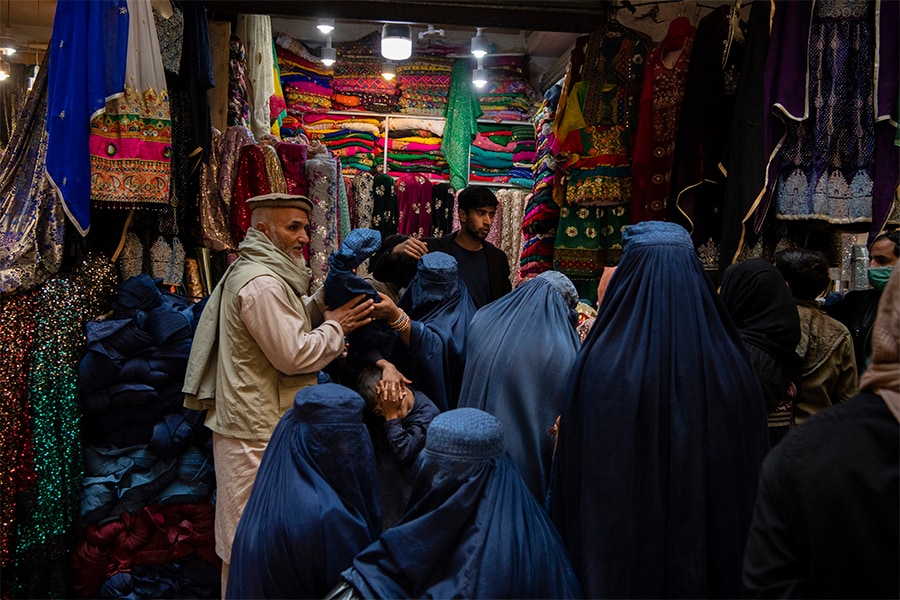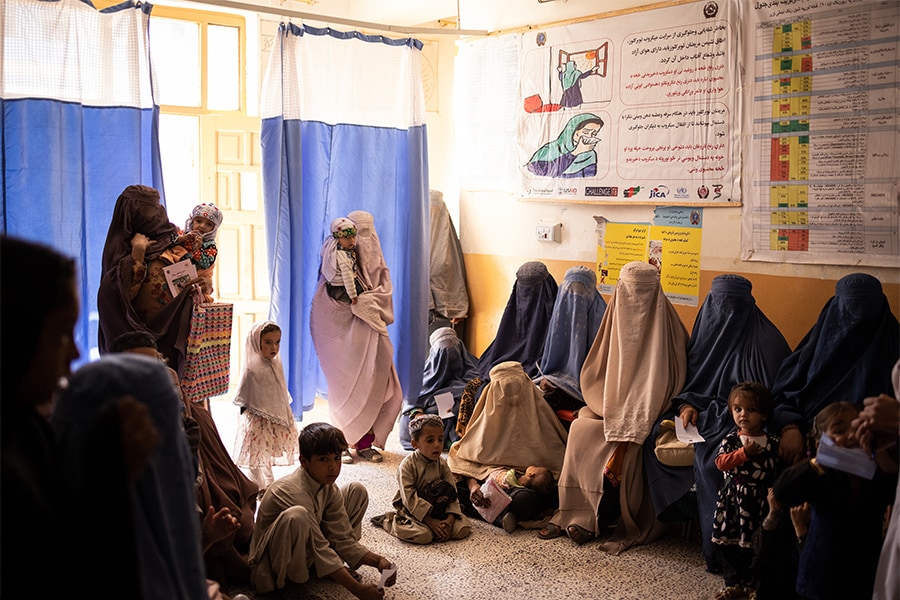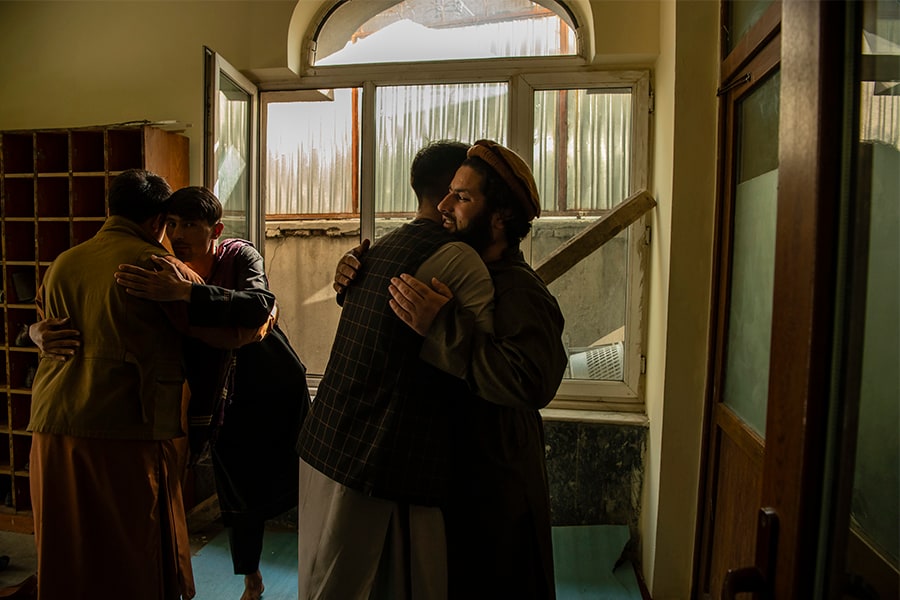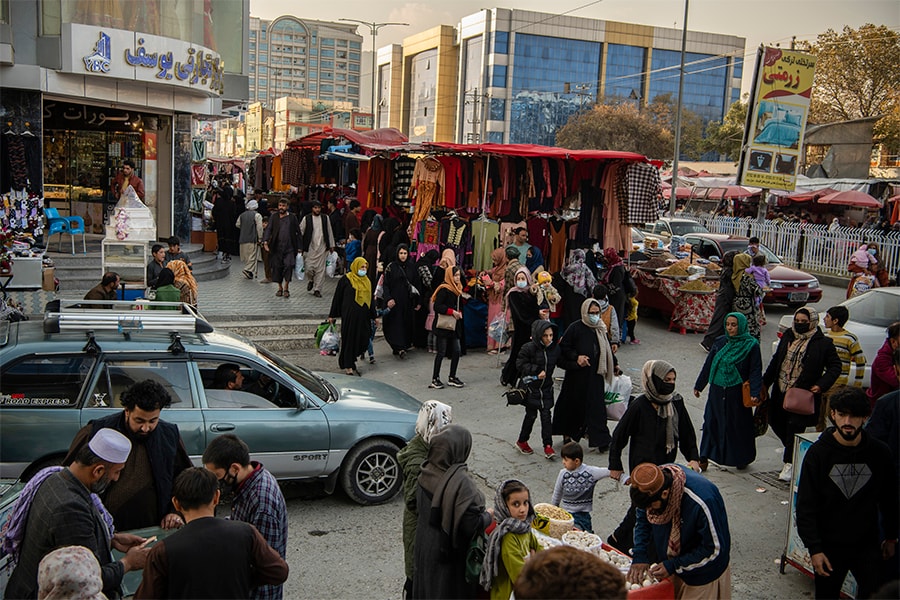Afghanistan’s only national park was filled with tourists who had only dreamed of traveling to its intensely blue lakes and jagged mountains when fighting raged across the country.
And Zulhijjah Mirzadah, a mother of five, packed a small picnic of dried fruit, gathered her family in a minibus and wove for two hours through the congested streets of the capital, Kabul, to a bustling amusement park.
From the entrance, she could hear the low whoosh of a roller coaster and the chorus of joyous screams from Afghans inside celebrating Eid al-Fitr, the holiday marking the end of the holy month of Ramadan. But she could not go further. Women, she was told at the gate, were barred by the Taliban from entering the park on Eid.
“We’re facing economic problems things are expensive we can’t find work our daughters can’t go to school — but we hoped to have a picnic in the park today," said Mirzadah, 25.
As Afghans endured the constant and random violence of the last two decades of war, many held hopes that when peace finally came to the country, Eid al-Fitr would be its high-water mark, a day when families long separated by fighting would finally be able to celebrate together.
![]()
FILE — Women wearing burqas shop at a market in Kabul, in Nov. 2, 2021. A new decree by the Taliban recommends, but doesn’t require that women wear burqas, and says male relatives of those who don’t cover themselves would be punished. Image: Kiana Hayeri/The New York Times
Now that war is over. People can travel freely down highways devoid of gunfire, roadside bombs and attempts at extortion. The terrifying drone of warplanes overhead is long gone. But for many, the holiday that began last Sunday in Afghanistan served as a reminder of the dissonance between the promise of peace many Afghans had imagined and the realities of the end of the war.
A crippling economic crisis that has slashed incomes and sent the prices of basic goods soaring forced many families to forgo for the first time the Eid traditions of new clothes or dried fruit. Mosques were emptier than usual after a recent string of explosions stoked fears of the return of terrorist attacks.
And many women in urban areas, who have been devastated by the Taliban government’s restrictions, found little reason to celebrate. On Saturday, the Taliban decreed that Afghan women must cover themselves from head to toe, expanding a series of onerous restrictions on women that dictate nearly every aspect of public life.
“To be honest, we don’t have Eid this year," said Mirzadah, who had spent the afternoon with her family sitting across the street from the park on a narrow strip of grass.
Most people in Kabul learned that the Taliban had announced the start of the holiday after a roar of celebratory gunfire thundered across the city the night of April 30. Afghanistan was the first Muslim country to officially declare a sighting of a full crescent moon, kicking off the start of the holiday.
![]()
FILE — A woman walks along the side of the Kabul–Kandahar Highway north of Ghazni, Afghanistan, in Dec. 8, 2021. The Afghan government stated that a “hijab" should cover not only a woman’s hair and face, but her entire body from head to toe. Image: David Guttenfelder/The New York Times
The following morning, hundreds of men with prayer rugs tucked under their arms filed into the Sher Shah Suri Mosque, a large Sunni mosque in the west of Kabul. Across the courtyard, they laid out the rugs in the shade of twisted tree branches while armed Taliban intelligence agents clad in camouflage pants and bulletproof vests patrolled the mosque’s grounds for threats — a stark reminder of the threat of violence that persists despite the end of 20 years of war.
In the two weeks leading up to the start of Eid this year, a bloody spate of terrorist attacks on mosques, schools and public gatherings killed at least 100 people, mostly Afghan Shiites, and stirred fears that the large prayers on the first day of Eid would be the next target.
At the Seyyed Abad Mosque, the largest Shiite mosque in the city of Kunduz in the country’s north, only around 50 worshippers arrived for prayers May 1 — compared with 400 to 500 people in previous years, attendees said. Many people, terrified of another blast, steered clear of the mosque altogether. But many of those who attended were motivated by a different fear: disobeying the Taliban government’s declaration that Eid began May 1.
Many Afghan Shiites cast doubt over the date — a day before Saudi Arabia and two days before Iran, a Shiite theocracy. But anxious about repercussions from the Taliban — which have employed police-state tactics to maintain order since seizing power — many attended Eid prayers Sunday, even as they continued their daylong Ramadan fast and refrained from celebrating in their homes.
![]()
FILE — Women in Burqas and children await treatment at a World Food Program-supported health clinic in Kandahar, Afghanistan, Oct. 21, 2021. A new decree by the Taliban recommends, but doesn’t require that women wear burqas, and says male relatives of those who don’t cover themselves would be punished. Image: Jim Huylebroek/The New York Times
“The Taliban did not threaten us that we must pray, but as soon as they came and told us that Eid prayers would begin on Sunday, and that they would come to provide security at the mosque, no one dared to tell them that we did not believe Eid had begun," said Mansoor, 33, a resident of Kunduz who preferred to use only his first name for fear of repercussions.
But for Taliban soldiers and police officers, the holiday offered a moment of reflection on the struggle that brought them back to power and the lives they have established for themselves since.
In the parking lot of one police station in Kabul, a gaggle of Taliban policemen arrived in a dark green pickup truck, weapons slung over their shoulder. Handcuffs dangled off the wrist of one police officer like a large bracelet, while another held to his nose a pink flower plucked from a median in the road.
![]()
Young men greet one another on Eid al-Fitr, the holiday marking the end of the holy month of Ramadan, during a gathering at the madrasa, an Islamic school, inside Shir Shah Mina Mosque, in Kabul, Afghanistan, May 1, 2022. For many in the country, the holiday is a reminder of the dissonance between the promise of peace many Afghans had imagined and the realities of the end of the war. Image: Kiana Hayeri/The New York Times
Mohibullah Mushfiq, 26, had spent every Eid in mountainsides and dusty villages away from his relatives since he joined the Taliban at 15 years old. But after the Taliban seized power, he moved his family from their village in the east to a third-floor apartment in Kabul.
On the first morning of Eid this year, he shared sweets with his 4-year-old son and 2-year-old daughter, both bouncing with excitement at the prospect of spending the holiday in the big city. He welcomed his government’s announcement about the start of Eid with pride.
“It shows our unity, our position in the Islamic tradition — they announced Eid, and everyone had to accept that," he said.
Nearby in the parking lot, Ubaidullah Edris, 21, talked quietly into his phone. On the other end of the line, his mother pleaded with him to come home to their village in Wardak, a mountainous province southwest of Kabul, to celebrate Eid.
Speaking to her made him homesick, he said. His entire life, Edris had spent Eid in his village, trekking up a mountainside to roast a goat or sheep with his friends. But, after hanging up the phone, his nostalgia for home was quickly replaced by the sense of duty he felt staying in Kabul on patrol.
“I miss my relatives, but I’m happy to be here serving the people, providing security — this was my big ambition," he said.
![]()
FILE — The Lycée Maryam open market in northern Kabul, in Nov. 2, 2021. The majority of women in the capital have continued to wear less encompassing versions of hijabs, leaving part of their faces still visible. Image: Kiana Hayeri/The New York Times
Across the country, some Afghans took advantage of the relative security the Taliban has been able to provide for Eid celebrations. Hundreds of domestic tourists flocked from around the country to Bamiyan, a province in central Afghanistan known for its natural beauty and ancient ruins, according to hotel owners and travel agents.
Parwin Sadat, 32, a private-school teacher, made a 27-hour trek to Bamiyan with her husband and 6-year-old child from the western city of Herat — a trip that would have been all but impossible during the war, when fighting along highways made cities islands of their own. Visiting Bamiyan left Sadat awe-struck, she said.
“I didn’t know that our country has such tourist destinations, historical places and so much beauty," she said.
But for many Afghans who have been crushed by the country’s economic collapse since the Taliban toppled the Western-backed government, the freedom of travel and luxury of celebratory outings remained out of reach.
City Park, the amusement park in Kabul, and the city’s zoo, had less than half of the number of visitors that typically come each Eid, according to park managers. The low turnout was a reflection of both the country’s economic downturn and the Taliban’s edict barring women from visiting on Eid — the latest in a growing roster of restrictions on women in public spaces.
In a modest house tucked into one of Kabul’s many hillsides, Zhilla, 18, gathered with relatives at her aunt’s house on the second day of Eid. Her young cousins and siblings chased each other in the small courtyard. Inside, Zhilla marveled over her new cousin, just 6 days old, sleeping peacefully in her mother’s lap.
“The baby knows we’ve been through a lot she needs to behave for us," Zhilla joked.
The previous year, she and her relatives had gathered by the city’s Qargha reservoir for a picnic by the river, as boys and girls rode bicycles along its banks and took boats out on the water — a memory that feels like a lifetime ago, she said.
“This Eid is the same as any other day — we cannot go out we cannot be free," she said.
This article originally appeared in The New York Times.







